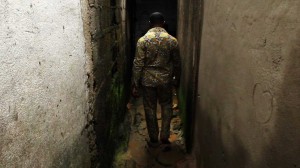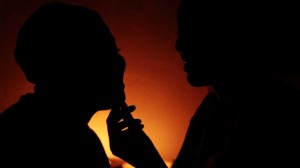
Final color grading was done at Colorflow with lead colorist Kent Pritchett working with the two filmmakers to set the final look. It was a challenging process due, in part, to the unusual circumstances surrounding the film’s production. As homosexuality is a crime in Cameroon punishable by lengthy prison terms, Kadlec and Tullman had to work incognito. They traveled under tourist visas and shot primarily with small, prosumer cameras, including a Canon DSLR.
Shooting was conducted in hotel rooms and other private locations. “We shot mostly indoors and kept a very low profile – not only to avoid contact with local authorities,” Kadlec recalled. “If our footage somehow was found by the wrong people, our subjects could be in real danger.”
In grading sessions, Pritchett worked to create consistency among source material shot with different cameras in widely varying locations and over a period of months. “A lot of it was shot in rooms with existing light – sometimes just a candle,” said Pritchett. “From a grading perspective it was interesting because despite the limitations in light, we needed it to be a bit brighter, yet still keeping it moody.”

Kadlec and Tullman were similarly convinced that their film had a lot of visual potential. Cameroon is a colorful country. Its people come from a range of ethnic groups and often dress in vibrant colors. Additionally, the southern part of the country is located in a lush, jungle environment. “We felt that our film offered a rich tapestry and was asking for a strong visual identity,” Tullman explained. “The vividness and richness was there, but it had to be pulled out. In a lot of scenes, the color seemed to lie under a gray veil.”
Pritchett used his Autodesk Lustre grading system to remove that veil, grading the film on a scene-by-scene basis, and coaxing detail, contrast and color from individual frames. “It was about keeping the richness of the African colors,” he explained. “The landscape is tropical, the trees lush and green but the ground was mostly red clay. It was so over the top, that I started to pull it back, but Shaun said, ‘No, that’s exactly how it looks.’ So it involved a delicate balance.”
“Skin tones were often very dark, while clothing tended to be bright and colorful – a lot of interesting contrasts,” Pritchett added. “In a lot of cases, we had to tone things down while retaining the feel. We wanted to give audiences a sense of what it is like there.”
While there was a lot of manipulation in the grade, it was all kept within the realm of reality. Kadlec and Tullman wanted to avoid color treatments that were artificial. “What Kent brought out was true to the film. He made it more vibrant, but didn’t turn it into something that it wasn’t,” said Tullman.
Born this Way recently premiered at the Berlin International Film Festival. In the next several months, it will screen at over a dozen international festivals.





